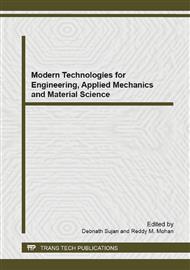[1]
Matthew, F.L., and Rawlings R.D. 1994. Composite Materials: Engineering and Science. Oxford: Chandos Publishing.
Google Scholar
[2]
McCauley, A. Ronald. 2004. Corrosion of Ceramic and Composite Materials 2nd Ed. New York: Marcel Dekker Inc.
Google Scholar
[3]
Askeland, Donald R., and Pradeep P. Phule. 2003. The Science and Engineering of Materials 3rd Ed. Canada: Thomson Canada Limited.
Google Scholar
[4]
Bahadur, P. and Sastry N.V. 2002. Principles of Polymer Science. England: Alpha Science International Ltd.
Google Scholar
[5]
Budinski, Kenneth G., and Michael K. Budinski. 2005. Engineering Materials Properties and Selection 8th Ed. New Jersey: Pearson Education, Inc.
Google Scholar
[6]
Budinski, Kenneth G., and Michael K. Budinski. 2005. Engineering Materials Properties and Selection 9th Ed. New Jersey: Pearson Education, Inc.
Google Scholar
[7]
Callister, W.D. 2003. Materials Science and Engineering 6th Ed. New York: John Willey & Sons Inc.
Google Scholar
[8]
Savage, G. 1992. Carbon-Carbon Composites. London, United Kingdom: Chapman & Hall.
Google Scholar
[9]
Ray, D and J. Rout. 2005. Thermoset Biocomposites. New York: Taylor & Francis.
Google Scholar
[10]
Zini, Elisa, and MariastellaScandola. 2011. Green Composites: An Overview, Polymer Composites 2011. 32(12): 1905- 1915. doi: 10. 1002/pc. 21224.
DOI: 10.1002/pc.21224
Google Scholar
[11]
Taj, Saira , Munawar Ali Munawar, and Shafiullah Khan. 2007. Natural Fibre-Reinforced Polymer Composites., Proc. Pakistan Acad. Sci. 44(2): 129-144.
Google Scholar
[12]
Mulinari, D.R., Cioffi M.O.H. and Voorwald H.J.C. 2010. Review on Natural Fibres/HDPE Composites: Effect of Chemical Modification on the Mechanical and Thermal Properties. New York: Nova Science Publishers.
Google Scholar
[13]
Mohanty, A.K., Misra M. and Drzal L.T. 2005. Natural Fibres, Biopolymers and Biocomposites. London: Taylor & Francis.
Google Scholar
[14]
Shinoj, S., R. Visvanathan, S. Panigrahi, and M. Kochubabu. 2011. Oil Palm Fibre (Opf) and Its Composites: A Review., Industrial Crops and Products 33 (1): 7-22. doi: 10. 1016/j. indcrop. 2010. 09. 009.
DOI: 10.1016/j.indcrop.2010.09.009
Google Scholar


